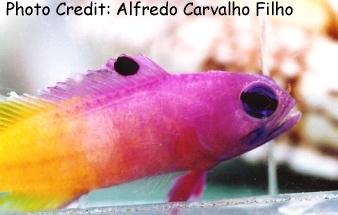
By Bob Goemans


Likely Reef Tank Suitable
Likely Fish-Only Tank Suitable
These small, 2 - 5 inch (5 - 12.5 cm) fishes belong in the Order Perciformes and Suborder Percoidei, and Family Grammatidae, which has 2 genera and 11 species all occurring in the Western Atlantic Ocean. They are plankton feeders, and prefer to inhabit areas near overhangs, crevices, caves, and steep ledges, and can be extremely territorial in guarding selected areas. It is not possible to distinguish males from females; however, the male is generally larger than the female in these species.
The Royal Gramma is the most popular species, and can reach 4 inches (10 cm) in length. They can be kept in small groups in larger aquaria (over 100 gallons), yet in small aquariums it may be best to maintain only one. They prefer a temperature range of 72 - 80F (22 - 27C) and since their natural diet consists mainly of zooplankton, they should be fed meaty/freeze-dried foodstuffs two or three time's daily. Should have numerous caves and hiding places, otherwise they may become quite territorial. Keep in mind they may eat small shrimps. Another in this genus, the Blackcap Gramma is also quite popular and requires the same aquarium husbandry. These are probably best last added to the aquarium, as they may become quarrelsome with further fish additions.
As for the Lipogramma genus, these reef basslets are a deeper water species than grammas. They are quite secretive and difficult to catch in the wild, therefore rarely show up in the trade. Usually shy when first placed in the aquarium and should have many hiding places. Keep in mind they may eat small crustaceans and are prone to hiding if kept under bright lighting. They have the same diet requirements as grammas.
For much more information on many of the species mentioned below, recommend reading "Basslets, Dottybacks & Hawkfishes" by Scott Michael ISBN 1-890087-33-5.